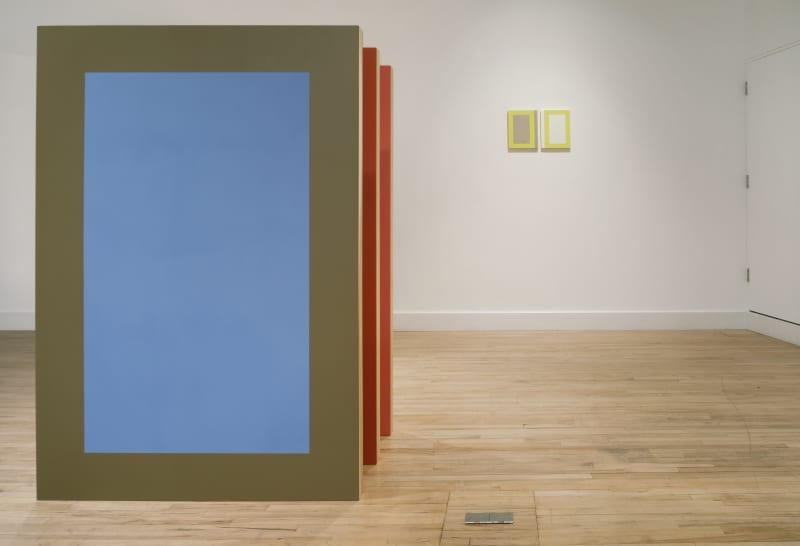Cooke Latham Gallery are pleased to present 'Conversations in Colour', a group exhibition of three female artists who utilise the language of colour to engage with perceptions of space and functionality, featuring new work by Rose Davey, Leah Guadagnoli and Erin O'Keefe.
Conversations in Colour
A text by Frances Whorrall-Campbell
Imagine you are looking at a house in the sun. The front is illuminated, and you appreciate the crispness of the red brick against the sky. Now turn to the shaded side of the house. The bricks are the same orange-red, but look closely. Can you see that they look colder, bluer even? The hot red brick advances towards you, whilst the shadow recedes coolly into the background: a phenomenon often used by painters to create the illusion of depth. However, the three artists gathered for Conversations in Colour use paint rather differently, invoking the feeling of space rather than its literal depiction.
Rose Davey's free-standing panels continue her obsession with the frame. Davey is a connoisseur of the shimmering stillness of a plane of colour, of the vibrating harmony that occurs at the border of the two tones. Davey has described her use of colour in terms of the 'light that dissolves the definition between two forms', reinforcing the ephemerality of this visual experience.
Davey's concern is with light and shadow as they apply themselves to the wall, rather than any solid form itself. The contrasting frames influence the projection and recession of the interior shape which hovers before its wooden support like a hologram. In this latest piece, the frame becomes a series of doors: we are implicated in an imaginary space but blocked from entry. The repeating panels display an austere purity which excludes or repels the human body, but also a playfulness that is deeply attractive.
Leah Guadagnoli continues this lively engagement with the body. Colour endows her forms with a vivaciousness and frivolity, that whilst playful, have (often quite literally) a sharp point. Dear Parvati, an abstracted vagina dentata brilliant in fuchsia and millennial pink, has a cheeky sensuality. Guadagnoli flirts with the gendered hierarchy of forms: soft, wavy lines but up against angular protrusions, inverted triangles which read as both yonic and phallic. Even the absurdity of her paintings' cartoonish scale undermines any supposed masculine claim for dominance. Colour Field painting is no longer a man's game: Guadagnoli is like a Miami Beach Ellsworth Kelly, art-deco signage in ice-cream shades.
The photographs of Erin O'Keefe display a similar concern with architecture. Her exacting use of perspective recalls the works of Renaissance artists such as Piero della Francesca, only it is now the camera, not the frescoed wall, that collapses imagined space. O'Keefe's photographs work like optical illusions, producing an enigmatic space that shifts between two- and three-dimensions. The works are created by photographing small still life arrangements of wooden blocks, hand-painted by the artist. The depicted spaces are therefore both 'real' and not: an image of a real space in a moment of time that flaunts the tactility of objects, whilst also setting them behind the curious optical flatness of a photograph.
As photographs of sculptures (which themselves appear almost like paintings), O'Keefe's works have conceptual and visual depth, whilst being physically shallow. In the space they function almost like a mirror, reflecting aspects of the other works and putting them into conversation. Like Rose Davey's paintings, O'Keefe's images both invite and block our entrance. Our eyes seem able to measure the weight and volume of the blocks and trace the brushstrokes around their faces, however, the photograph folds this space back into itself making it seamless and flat: we end up tracing the smooth surface of the print instead.
The painstaking construction of these tableau recalls the energy of Guadagnoli's shapes, yet O'Keefe's assemblages are stilled. If Guadagnoli's forms hang suspended on a wall, photography suspends the shapes in time, turning the initial absurdity into a more profound reflection on the gap between vision and experience.
What all three of these artists have in common is the dominance of their palette. Colour sings throughout this exhibition, a vibrant chord echoing through enigmatic and energetic spaces, spaces evoked by these very same tones.



